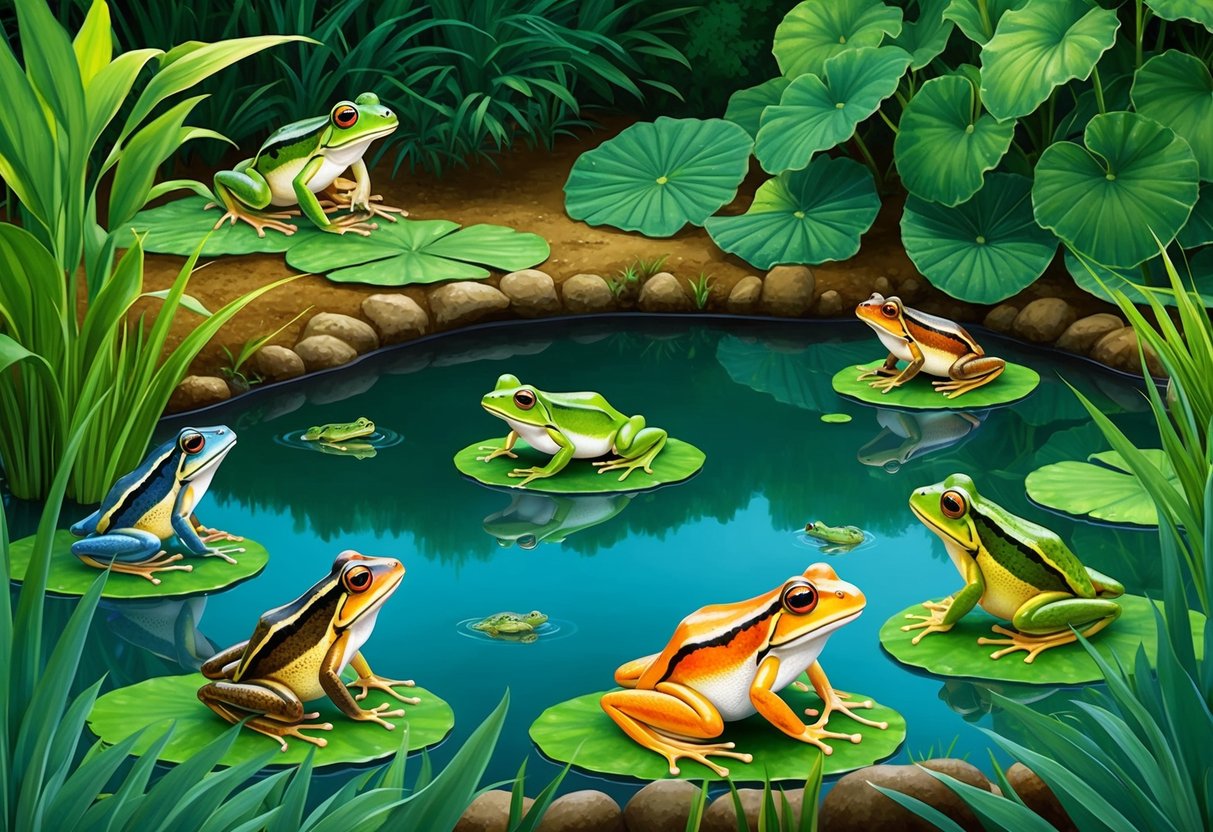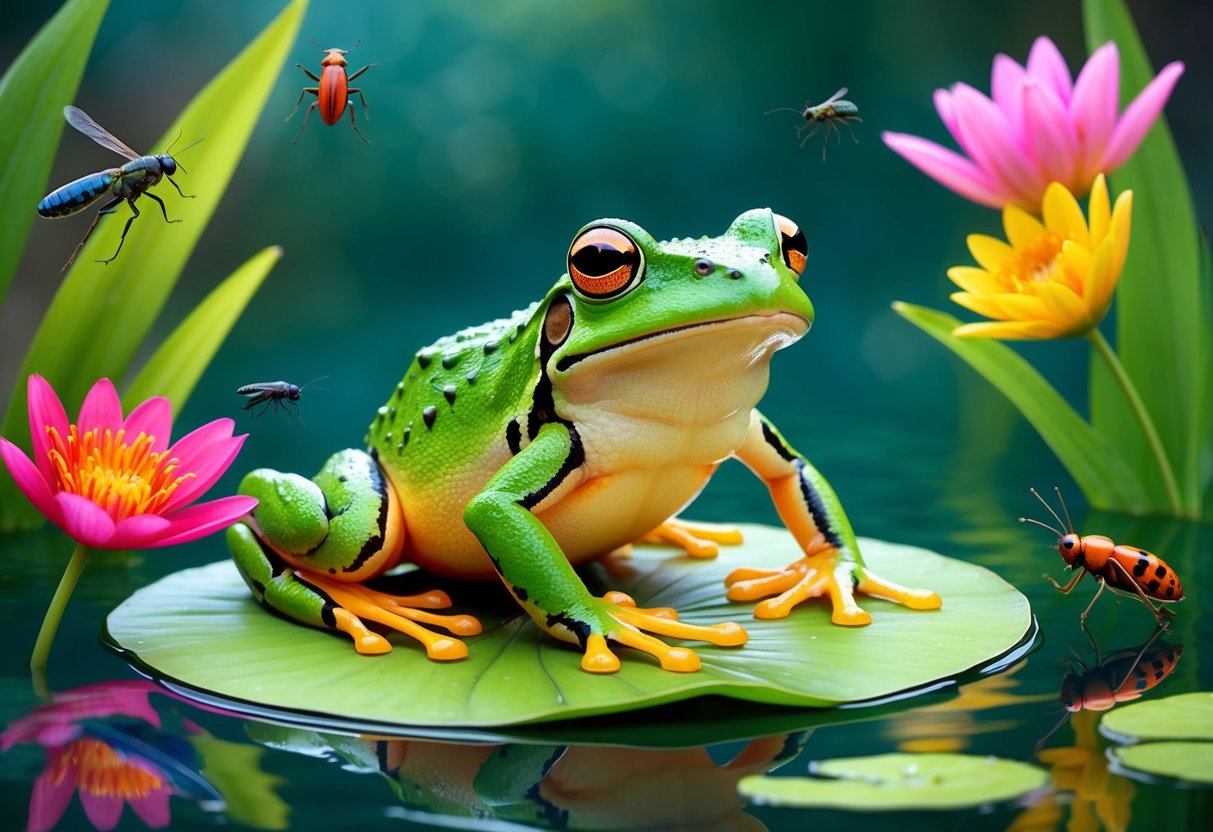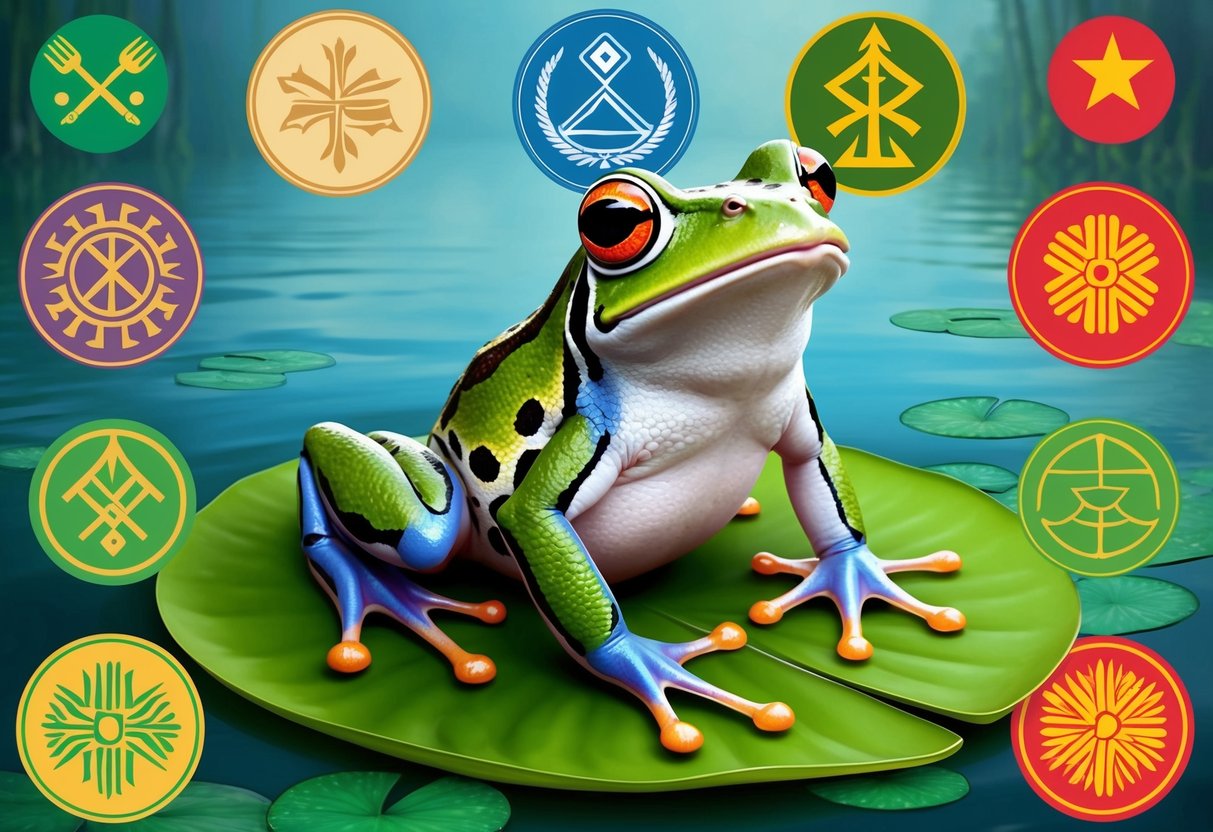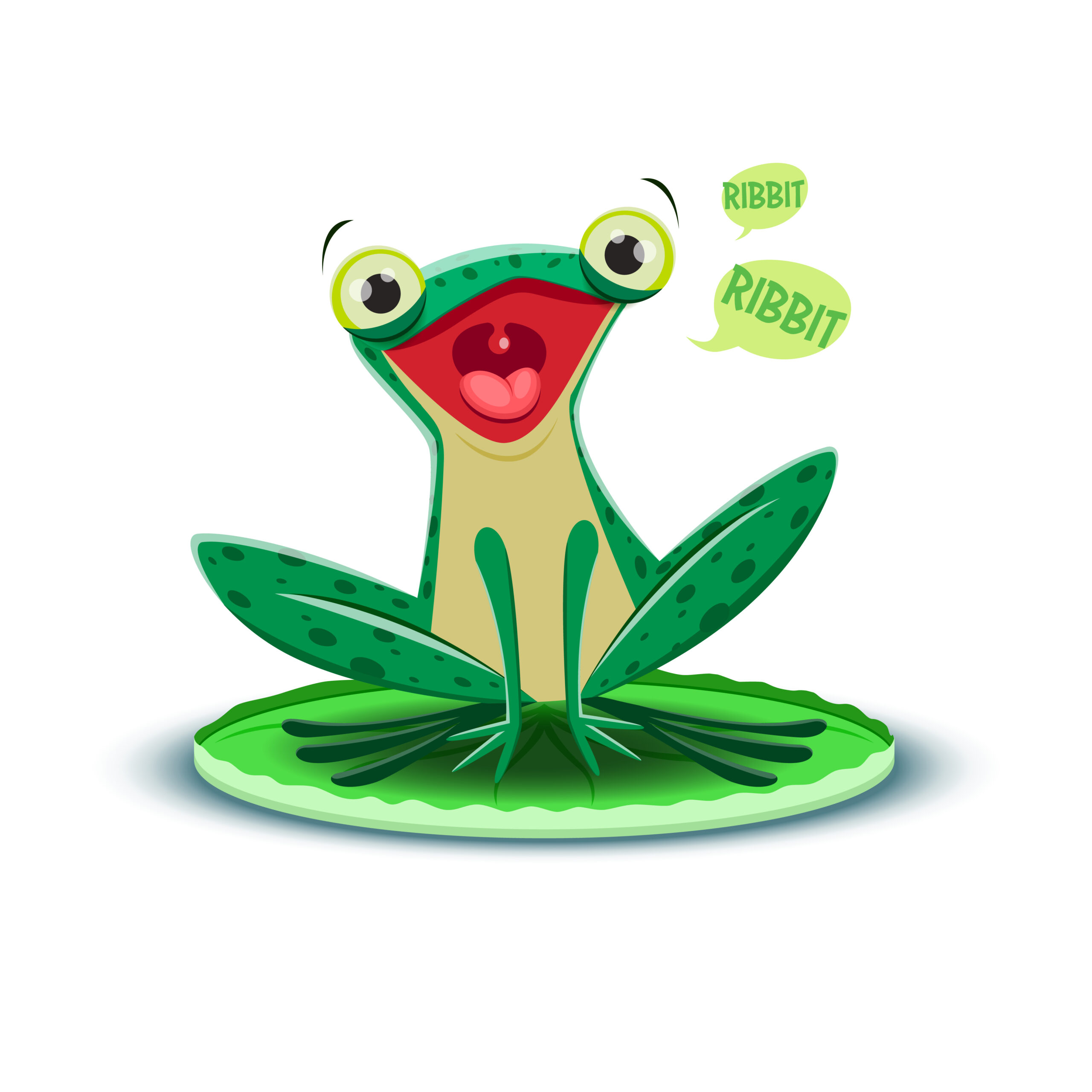The Symbolism of Frogs in Different Cultures: Ancient Meanings and Modern Interpretations
Frogs have captivated human imagination for centuries. These small amphibians hold deep symbolic meanings in many cultures around the world.
From ancient Egypt to modern Japan, frogs represent different ideas and values.

Frogs symbolize transformation, fertility, and renewal in various traditions. Their life cycle, from tadpole to adult, mirrors the process of personal growth.
Some cultures see frogs as lucky charms, while others view them as signs of impending rain or change.
The symbolism of frogs differs across societies. Native Americans link frogs to cleansing and rain. In Japan, frogs are tied to good fortune. European folklore often portrays frogs in magical tales.
These varied interpretations show how one creature can hold many meanings.
Key Takeaways
- Frogs hold diverse symbolic meanings across cultures worldwide
- The amphibian’s life cycle often represents transformation and renewal
- Frog symbolism appears in ancient traditions, modern culture, and environmental contexts
Historical Significance of Frogs in Ancient Cultures
Frogs held great symbolic importance in many ancient cultures. They were often linked to fertility, transformation, and spiritual powers.
Egyptian Mythology and Heqet
In ancient Egypt, frogs were highly revered. The Egyptian goddess Heqet had the head of a frog and was associated with fertility and childbirth.
Egyptians saw frogs as symbols of life and rebirth. This was likely due to the frog’s ability to live both in water and on land, as well as its metamorphosis from tadpole to adult.
Heqet was often shown holding an ankh, the symbol of life. She was believed to assist women during childbirth and protect newborns.
Frogs in Greek and Roman Traditions
Ancient Greeks and Romans also linked frogs to fertility and harmony. They associated these amphibians with Aphrodite, the goddess of love.
In Greek mythology, frogs were sometimes seen as agents of transformation. This belief may have stemmed from the frog’s dramatic metamorphosis during its life cycle.
Romans viewed frogs as symbols of licentiousness. They often depicted frogs in art and literature, using them to represent various aspects of their culture and beliefs.
Native American Lore
Many Native American tribes saw frogs as rain bringers and cleanser. They believed frogs had the power to summon rainstorms and purify both the physical and spiritual realms.
In some tribes, frogs were linked to healing and medicine. Shamans might use frog imagery or even parts in their rituals and treatments.
Frogs also featured in creation myths of certain tribes. These stories often portrayed frogs as wise creatures with deep connections to the earth and water.
Frogs in Asian Cultures
Frogs hold deep symbolic meaning in Asian cultures. They are often linked to good fortune, prosperity, and natural cycles.
Let’s explore their significance in Chinese and Japanese traditions.
Chinese Cultural Symbolism
In China, frogs are seen as lucky creatures. The three-legged money frog, Ch’an Chu, is a popular symbol of wealth. People place these frog statues in homes and businesses to attract riches.
Frogs also represent yin energy in Chinese culture. This connects them to feminine qualities and the moon.
In feng shui, frog figures are used to create harmony and balance in spaces.
Chinese myths tell of Jin Chan, a magical three-legged frog. It’s said to appear during full moons, bringing good fortune to those who see it.
Japanese Folklore
Japanese culture views frogs as symbols of good luck too. They’re linked to safe travels and returning home. This comes from the word “kaeru” meaning both “frog” and “to return”.
Frogs feature in many Japanese folk tales. One famous story is about a frog who saves a town from a giant snake. This tale shows frogs as brave and helpful creatures.
In Japan, frogs are also tied to rainfall and agriculture. Farmers see them as good omens for crops. Some shrines even have frog statues to pray for rain.
European Interpretations

Frogs hold diverse symbolic meanings in European cultures. Their interpretations have evolved over time, reflecting changing beliefs and societal values.
Medieval Europe and Witchcraft
In medieval Europe, frogs were often linked to witchcraft and dark magic. People believed witches used frogs as familiars or ingredients in potions.
This association stemmed from the frog’s ability to live on both land and water, seen as unnatural.
Frogs also appeared in Christian symbolism during this period. Some viewed them as symbols of sin or temptation, while others saw them as representations of resurrection due to their transformative lifecycle.
Medieval bestiaries, illustrated books about animals, often depicted frogs alongside moral lessons. These texts reinforced the frog’s complex symbolism in European thought.
Victorian Symbolism
Victorian-era interpretations of frogs shifted towards more positive associations. Frog imagery became popular in art and literature, often symbolizing transformation and renewal.
In Victorian fairy tales, frogs frequently appeared as enchanted princes. This motif highlighted themes of inner beauty and the power of love to bring about change.
Frogs also gained popularity in Victorian decorative arts. They adorned jewelry, ceramics, and textiles, representing good luck and prosperity.
The scientific advancements of the era led to a greater understanding of frog biology. This knowledge influenced artistic depictions, making them more naturalistic while retaining symbolic meanings.
Frogs in Modern Popular Culture

Frogs continue to hop into our hearts through movies, TV shows, and other media. These amphibians often play key roles as lovable characters or symbolic figures.
One famous frog is Kermit from The Muppets. His green face and catchy songs have made him a beloved icon for decades.
Kermit shows how frogs can represent transformation and renewal in modern storytelling.
Video games also feature frogs prominently. The classic arcade game Frogger had players guide a frog across busy roads and rivers. This game’s popularity helped cement frogs as fun, agile creatures in pop culture.
Frogs appear in memes and internet culture too. The “Feels Good Man” frog face became a widely shared image online.
This shows how frog imagery can spread quickly in digital spaces.
Children’s books and cartoons often use frogs as main characters. These stories teach kids about nature, friendship, and growing up. Frog characters help make these lessons fun and memorable.
Even in advertising, frogs make their mark. The famous Budweiser frogs commercial from the 1990s is still remembered today. Their croaking of the brand name became an instant hit with viewers.
Frogs as Environmental Indicators
Frogs play a crucial role as environmental indicators. Their permeable skin makes them highly sensitive to changes in their surroundings.
This sensitivity allows frogs to serve as early warning systems for ecosystem health.
Scientists often use frog populations to monitor environmental quality. Declining frog numbers can signal problems like pollution, habitat loss, or climate change.
Healthy frog populations, on the other hand, typically indicate a balanced ecosystem.
Frogs respond quickly to environmental changes. They can show signs of stress or illness before other animals. This makes them valuable for detecting potential threats to ecosystems.
Some key ways frogs act as environmental indicators:
- Skin abnormalities
- Population declines
- Changes in breeding patterns
- Malformations in tadpoles
Researchers study these factors to assess ecosystem health. They use this data to inform conservation efforts and environmental policies.
Frogs’ dual life cycle, both in water and on land, gives them a unique perspective. They can reflect the health of both aquatic and terrestrial environments. This makes them especially useful for monitoring overall ecosystem balance.
Spiritual and Religious Representations

Frogs hold deep spiritual meaning in many faiths and cultures. Their life cycles and behaviors often symbolize important religious concepts.
Christianity and Resurrection
In Christianity, frogs have a complex symbolism. The Bible mentions frogs as one of the plagues sent to Egypt. This links them to divine punishment.
But frogs also represent positive ideas. Their transformation from tadpole to adult frog mirrors the Christian concept of resurrection. This change symbolizes spiritual rebirth and renewal.
Some Christians see frogs as symbols of God’s creative power. Their unique life cycle shows the wonder of creation.
Indigenous Spiritual Beliefs
Many indigenous cultures view frogs as sacred creatures.
Native American tribes often connect frogs with rain, clear water, and rebirth. They see a strong link between frogs and moon energy due to their ties to water.
Frogs play a role in creation myths for some tribes. They may represent wisdom, fertility, or cleansing.
In some beliefs, frogs act as spirit guides. They help people through life changes and spiritual growth.
The frog’s ability to live in two worlds – water and land – gives it a special place in many indigenous spiritual practices.
Interpretations in Literature and Art
Frogs have hopped their way into many literary works and art pieces over the years. Their unique qualities make them perfect symbols for various themes.
In literature, frogs often represent transformation and personal growth. This stems from their life cycle, changing from tadpoles to adult frogs.
Writers use frogs to symbolize adaptability, wisdom, trickery, and balance.
Artists frequently depict frogs in their work. In paintings and sculptures, these amphibians can represent fertility, abundance, and renewal.
Frogs appear in fairy tales as enchanted princes, waiting to be transformed by a kiss. This portrayal links to ideas of hidden potential and unexpected change.
In some stories, frogs act as wise characters. They offer advice or guide the hero on their journey. This reflects the frog’s connection to water and emotions in many cultures.
Modern art and literature continue to use frog symbolism. These creative works often explore themes of environmental change and human impact on nature.
Frequently Asked Questions
Frogs hold diverse symbolic meanings across cultures, religions, and mythologies. These amphibians often represent transformation, fertility, and good fortune in various belief systems.
What are the spiritual implications of frog symbolism in various cultures?
Frogs symbolize personal growth and transformation in many cultures. They also represent renewal, adaptability, and life’s cyclical nature.
In some traditions, frogs are seen as messengers between the physical and spiritual worlds. Their ability to live both on land and in water connects them to different realms of existence.
How is the frog perceived in Christian symbolism?
In Christian symbolism, frogs have a complex representation. They are sometimes associated with plagues, as mentioned in the Bible’s Book of Exodus.
However, frogs can also symbolize resurrection and rebirth due to their life cycle. This dual nature makes them intriguing symbols in Christian art and literature.
What role do mythological frog creatures play across different mythologies?
Mythological frog creatures appear in various cultures’ stories and legends. In some Native American myths, frogs are creators or bringers of rain.
In European folklore, frogs sometimes feature in tales of transformation, such as the story of the Frog Prince. These stories often carry moral lessons or explore themes of change and identity.
How are frogs represented in ancient Egyptian culture?
The ancient Egyptians associated frogs with fertility and birth. The goddess Heqet, often depicted with a frog’s head, was linked to childbirth and renewal.
Frog amulets were common in ancient Egypt, believed to provide protection and ensure rebirth in the afterlife. These small objects show the importance of frogs in Egyptian spiritual beliefs.
What is the significance of frogs in Chinese cultural beliefs?
In Chinese culture, frogs are symbols of good luck and prosperity. They are often associated with money and financial success.
The three-legged money frog, or Chan Chu, is a popular feng shui symbol. It’s believed to attract wealth and ward off bad luck when placed in homes or businesses.
In what ways are frogs significant in Japanese traditional symbolism?
Japanese culture views frogs as symbols of good fortune and safe travels. The word for frog in Japanese, “kaeru,” is a homonym for “return.”
Frog figurines are often given as gifts to travelers, wishing them a safe return home. In Japanese art, frogs frequently appear in paintings and sculptures, representing rain and abundance.
